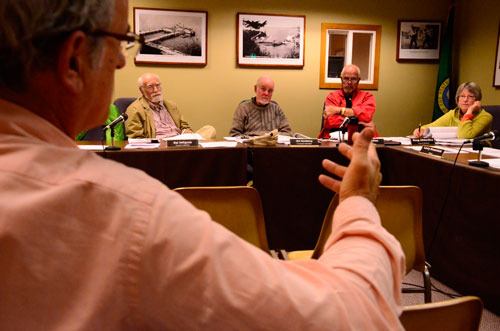Langley Mayor Larry Kwarsick has big plans in store for the Village by the Sea and he made that clear Monday by putting forward a 2013 budget to the City Council that is nearly double that of 2012.
While more than half of the money consists of unsecured funds, including grants, loans and a bond, all of which would be put toward capital projects, the $11.3 million total is a 48 percent increase over last year’s $5.5 million budget.
Kwarsick said past budgets have been narrower in scope, lacking prospective funding strategies for large-scale and long-range projects.
“We’ve tried to be a bit more comprehensive this time around, talking about the big picture,” Kwarsick said. “The vision we’ve tried to create in our budgetary policies take advantage of low interest bonding opportunities and looking at ways to try and invest in our own economy and stimulate our own economy.”
The budget is especially heavy on infrastructure improvements, with specified projects totaling about $6.5 million, according to city documents. Broken down, it tabs out to about $2.8 million in loans, $3 million in grants and a $700,000 bond.
The loans would all be paid back with revenue generated from the city’s various utilities, due in part to rate increases that were adopted by the City Council earlier this year and in 2011.
The focus on infrastructure is largely unprecedented, according to Debbie Mahler, Langley’s clerk/treasurer.
“I think there is more infrastructure improvements in this budget than the city has ever done in five years, let alone one,” Mahler said. “This is very aggressive and ambitious.”
At the top of the list, and the line item some city officials say may be the least assured, would be $1.4 million in state and federal grant money for the Street Fund. A $700,000 bond would also be pursued, totaling about $2.1 million in new revenue.
The money would largely be put toward the Second Street redevelopment project, which is expected to run about $1.7 million. The remainder, along with existing revenues, would fund engineering of a funicular from Cascade Avenue to the marina, install two radar speed signs, overlay sections of Anthes and Park avenues, overlay all of Camano Avenue and Sixth Street, and seal-coat Island View Lane.
In the Water Fund, a $780,000 loan and $260,000 grant, both from the United States Department of Agriculture, is slated to pay for water line improvements on Decker and Park Avenues, Second Street, Sandy Point Road and in Northview.
From the same federal agency, the city is seeking a $935,000 loan and $765,000 in grants for stormwater projects in a handful of locations, from Sixth Street and Edgecliff Drive to Melsen Alley and Wharf Street.
Similarly, a $1.1 million loan and a $381,500 grant is being pursued for the Sewer Fund to pay for extensions and improvements in locations such as Edgecliff and Saratoga to Cedar Circle. That money would also come from the department of agriculture.
Finally, county and state grants totaling $220,000 are hoped for the General Fund to pay for a proposed Sunday bus pilot program between Langley and the Clinton ferry terminal and for a conservation easement at Noble Creek.
Another highlight of the 2013 budget, which is not paid for with grant, loan or bond money, includes the hiring of a fourth police officer. Overtime costs for existing officers were determined to nearly equal that of the additional officer.
The budget also proposes a 4-percent cost of living increase for the city’s 13.5 staff, totaling about $31,000, and a 1-percent performance bonus awarded to six workers who earned enough points through a city employee incentive program. The bonuses total about $3,550.
Just one person from the public, Langley resident Robin Adams, attended Monday’s hearing on the budget. He expressed several concerns about the slated infrastructure projects, both in terms of the public’s capacity to afford them and the city’s ability to manage them with such a tiny staff.
He noted that the city has seen little to no growth in the past 10 years, yet residents are tasked under this budget to shoulder a heavy burden. Councilman Jim Sundberg argued that residents aren’t being asked to pay much more as the loan funds would be paid for by the existing rates structure. Property taxes are set to go up by the legal limit of 1 percent.
“The point is the money has to come out of people’s pockets,” Adams said.
“The taxpayer ends up paying one way or another,” he said.
Kwarsick acknowledged the concerns, saying the “point is well taken.” However, he said there are indications of a housing spurt next year and that will help. As for managing so much work with so little staff, he said it that is a problem he will happily take on.
“It will be a challenge but it will be a pleasant challenge,” Kwarsick said.
The City Council will hold another public hearing on the 2013 budget at its next regular meeting, Nov. 19. State law requires the budget to be adopted before the end of the year.



